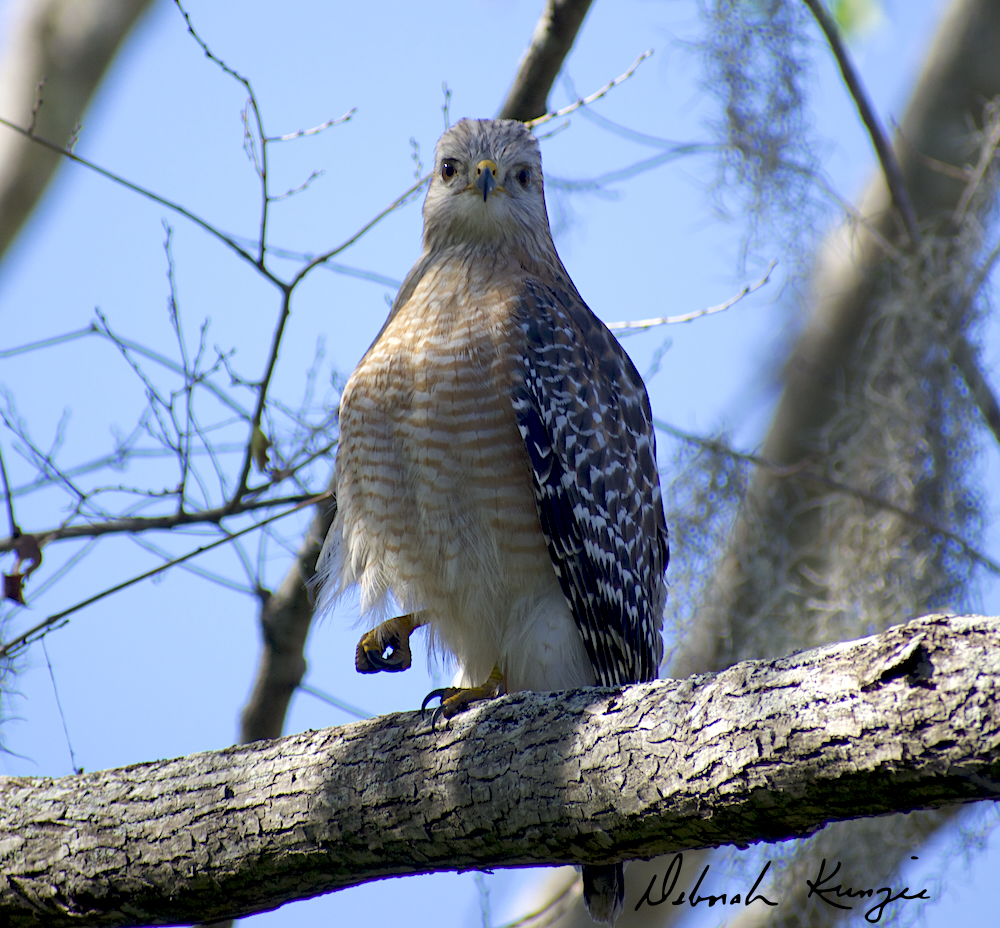
There’s a quality to morning light in early spring that defies description—soft yet revealing, gentle yet insistent. It was in this light that I found myself face to face with the Red-shouldered Hawk pictured here, both of us seemingly surprised by our mutual discovery.
I’ve been walking these woods near my new home for a few weeks now, deliberately without my camera. Perhaps I was resting my eyes. Perhaps I was resting something deeper. The knees, as many of you fellow septuagenarians know all too well, protest more vocally with each passing day. It becomes easier to leave the equipment behind, to tell yourself you’re simply “being present” without the mediation of a viewfinder.
But presence, I’m rediscovering, takes many forms.
Mary Oliver, that keen-eyed poet of the natural world, once wrote: “To pay attention, this is our endless and proper work.” For decades, my camera has been the instrument of my attention, the tool through which I’ve practiced this endless and proper work. Without it these past months, I’ve felt a curious absence.
This hawk was merely the tipping point in what had become an overwhelming chorus of winged presence. It wasn’t a single encounter, but a gradual accumulation—the influx of migratory birds announcing spring with their urgent wingbeats, the patient herons standing at the pond’s edge each morning, the great horned owl’s haunting calls that pierce the gathering dusk. Each day without my camera had become a ledger of missed moments, a catalog of images preserved only in the faulty archive of memory.
The moment with the hawk passed, as moments do. It took flight with three powerful beats of its wings, but something remained behind—a rekindling, an awakening. I returned home with a decision already made.
The next morning found me with my trusted Nikon slung across my shoulder, its familiar weight both comforting and challenging. The knees still complained, but with less conviction. When I encountered this same hawk—or perhaps its mate—on that branch, I was ready. The muscle memory returned instantaneously: the slight adjustment of aperture, the gentle pressure of the shutter release, the held breath of concentration.
Ansel Adams, whose dedication to the craft I’ve long admired, once said that “a photograph is not an accident—it is a concept.” In my younger days, I might have agreed wholeheartedly. I would hike miles with tripod and equipment, seeking the perfect vantage point, waiting hours for ideal light. It was concept, execution, deliberate vision.
Now, I find a different truth emerging. Sometimes a photograph is simply a recognition of grace—the grace of being in the right place, of having prepared yourself through decades of practice to receive what the world offers in an instant.
This hawk didn’t pose for me. It simply continued its morning vigilance while I, camera once again in hand, bore witness. The image isn’t technically perfect—I’m still shaking off the rust of disuse—but it captures something essential: two beings sharing a moment in time, connected through the act of seeing and being seen.
I once heard a Tlingit elder say that when you take a photograph of something wild, you’re not capturing it but rather accepting an offering. This perspective feels increasingly true as I age. The hawk offered me not just its image but a rekindling of purpose.
The camera now sits by my door, ready for when I go on my morning walks. The weight that once seemed burdensome has transformed back into invitation. My knees still creak a protest with each downhill stretch, but they’re in negotiation with a stronger force—the pull of connection that comes from documenting these brief, luminous encounters.
Mary Oliver again provides the words that elude me: “I don’t want to end up simply having visited this world.” At seventy, with fewer days ahead than behind, the answer clarifies: I plan to witness. I plan to attend. I plan to carry this familiar weight through these woods, around these ponds, in service to moments of recognition like this one—a Red-shouldered Hawk, motionless against a blue spring sky, its gaze both a challenge and gift.
The part of me I’d left at home has returned. And with it, a quality of attention that makes each step, each twinge of aging joints, each early morning rising worth the effort. The camera, I’m reminded, isn’t just a tool for making images—it’s a passport to heightened awareness, to deeper presence.
And that, my friends, is a weight worth carrying.